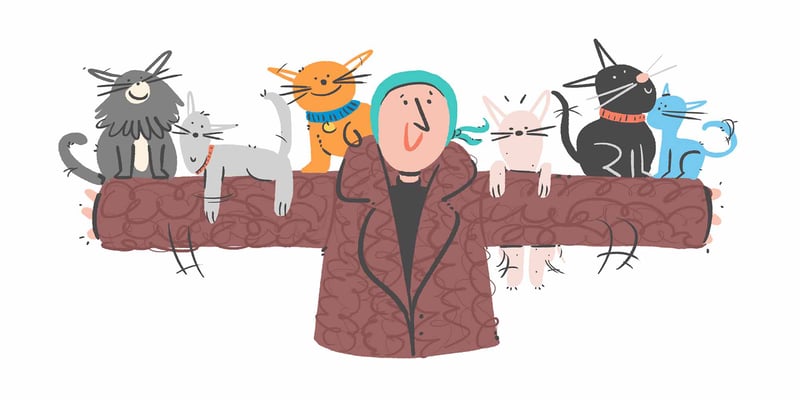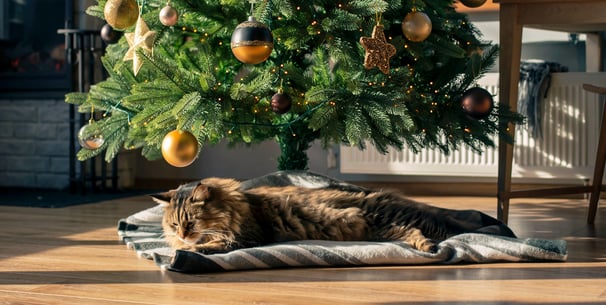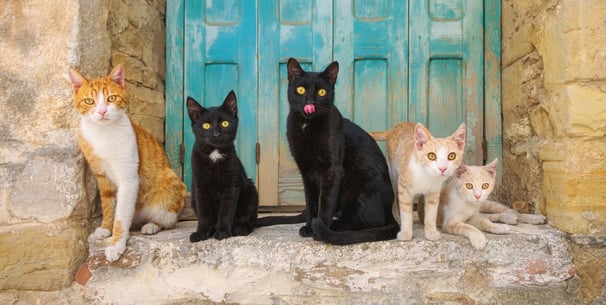Index:



Introduction
You’ve heard the word ‘spinster’, right? How about 'thornback’? Whilst we might refrain from using such derogatory language nowadays, these words belong to an insulting group of expressions and phrases used to describe (usually single) women. The most easily recognisable icon from this group is the Crazy Cat Lady, wired deep into popular culture and ever present in the media - this trope is an archetype of humour at the expense of women.
She’s appeared in countless tv shows and films; think Angela from The US Office taking her cats to work and keeping them filed away (#SaveBandit), Eleanor Abernathy from The Simpsons who speaks gibberish and uses her cats as bowling balls - yes, the deranged cat lady has a name! - or the reclusive Little Edie in Grey Gardens.
She’s typically pathetic, unhinged, a failure at romance, and just an all-round pitiful woman with nothing to come home to but her cats. But when we stop to think about it, where did this trope come from? Does it have a much more sinister meaning? And, is it finally time for the media to let it go and move on?
In 2023 when, statistically speaking, more men own cats than women do, shouldn’t we be looking to explore and reclaim such a damaging and sexist trope? And why is owning a cat deemed a 'bad thing' for single women when we all know the long list of mental and physical benefits a pet can bring?
Whilst it might seem easy to brush it off as a harmless joke, the crazy cat lady isn’t just a stereotype that women are lonely but that they are mentally ill and deranged. Pop culture has worked incredibly hard to keep the crazy cat lady trope alive but you’ll find it deeply rooted in years of patriarchal injustice.
Where did the crazy cat lady come from?
Cat ladies are everywhere in popular culture. From Stanley Kubrick’s A Clockwork Orange to Tim Burton’s Batman Returns, this trope has been infused into our consumption of film and television for a long time. Whilst it might seem a product of 20th-century contemporary media, its roots spread back to the 13th century and a fear of female power.
In ancient times, women and their cats were something to be celebrated. Hard to believe, I know. Freya, the Norse goddess of love and fertility, was such a badass that she rode a chariot driven by cats - the dream mode of transportation, in my opinion. But she’s not the only goddess whose relationship with cats was acknowledged.



There’s the Chinese goddess, Li Shou, and the Egyptian half-woman, half-cat goddess, Bastet. This perfect harmony between femininity and felines was worshipped for many years which makes me question, why did this suddenly change and why did female/feline companionship become a sign of mental instability?
The answer to those questions isn’t difficult to find. In the Middle Ages, the Roman Catholic Church wanted to rid the world of all non-Christian gods. This stripped women of a lot of power and anything other than the Holy Trinity was considered evil. Even cats themselves became known as Satan’s little helpers.
Pope Gregory IX despised cats so much that he officially declared in 1233 that Satan himself was half-cat and could take on the form of cats. Sadly, this fear led to the killing of many cats during the 14th century as Europeans feared that cats were spreading the plague. We all know now that this was, in fact, rats. And who could have killed these rats? You guessed it, the cats - had they been spared a nasty death.
A potential reason for such dislike of cats is because they simply aren’t dogs. Cats are independent, they come and go as they please, they’re self-sufficient and don’t require as much attention (a generalisation, I know there are some needy cats out there) but it’s often true. Cats are picky about who they like, they’re unpredictable, and are very specific about who they bond with.
Back to the 13th century. Women who tried to leave the church or followed a different religious belief were labelled as witches and often killed. These women were also typically poor, single, widowed, or elderly. This meant that they were unprotected by society and essentially powerless - starting to see a pattern here?
If a woman was content with singledom and owned a cat, this caused great suspicion. How could a woman be happy without a husband and children? Mass outrage saw innocent women (and innocent cats) lose their lives at a very young age. The fact that a woman could thrive in life without assistance was incomprehensible, therefore she must be committing some supernatural act, duh.
Because of a general public dislike of cats already, they quickly became synonymous with witches and non-Christian movements. In 1484, Pope Innocent VIII (pretty ironic name) publicly condemned all human and cat companions to death famously writing, ‘the cat was the devil’s favourite animal and idol of all witches.’
Fast-forward to 1566, and everyone still hates witchy women and cats. This was also the year of the first witch trial in England where Agnes Waterhouse and her cat were killed. Her cat, Satan, was a murdering, blood-drinking pet. Obviously.
This fear of women and cats carried through for years leading to the Salem Witch Trials in the United States over a hundred years later in 1692. During this time, many women and their beloved cats were killed at the hands of men who were threatened by their power and presence in the world.
However, something shifted in the early 18th century. Witch trials were acknowledged as a miscarriage of justice so instead of an apology and equality, women were pitied, and so were their cats.
Women were no longer threatening supernatural beings with demonic cats but rather pathetic, especially the ones with no children or husbands. Single women were nuisances, relying on relatives for financial support. With no access to jobs or money, life for women was pretty dire.
The view of single, widowed, or elderly women as old maids is said to have laid the foundations for the crazy cat lady trope. In 1880, the Dundee Courier reported:
“There is nothing at all surprising in the old maid choosing a cat as a household pet or companion. Solitude is not congenial to human nature, and a poor forlorn female, shut up in a cheerless ‘garret,’ brooding all alone over her blighted hopes, would naturally centre her affections on some of the lower animals.”
In the early 20th century, women began to campaign to receive the right to vote. Of course, men felt threatened by this. If women had a say in politics, what else would they want? Access to their own money or a job? How preposterous.
Cats suddenly became the figurehead of the anti-suffrage movement and were used in propaganda to show how silly suffragettes were. This propaganda had a double meaning. In these posters, cats were dressed up in women’s clothing to portray women as animalistic and trifling and to show that women’s rights activists were lonely old spinsters who hated men.



This mockery has carried on ever since and made its way onto our tv screens in a more nuanced way throughout the 20th century. So surely it’s time to drop the act, why are women who own cats still an easy target and a sneaky way to ridicule an entire gender, especially when we collectively know that cats aren’t evil but are beautiful and multi-faceted pets?
Can this trope be reclaimed?
It wasn’t until the 1960s that attempts at challenging the crazy cat lady trope were recognised, primarily due to second-wave feminism. Carolee Schneemann, a visual artist, incorporated her pet cats into her artwork. Cats became her muse and she began to turn the idea on its head that women who owned cats didn’t have to be lonely old spinsters but could be independent, sensual, and confident.
It seems that finally, in 21st-century life, we’re making moves in terms of reclaiming the crazy cat lady trope. Visit any cat-themed Etsy store or independent business and you’ll see a plethora of cat lady gifts and prints created by women, for women. There are even cat conventions that encourage guests to embrace their inner cat lady.
Even celebrities are self-proclaimed cat ladies, including Taylor Swift who is utterly besotted by her three cats (because why wouldn’t you be?). She takes her cats out and about on day trips to New York City and even includes them in her music videos - truly the best Cat Mum of them all.
Whilst the relationship between women and cats is more widely accepted and celebrated, no matter what we do it still seems to be reinforced countless times within popular culture.
Take the 2009 documentary, Cat Ladies, for example, instead of breaking down the stereotype of the crazy cat lady, the filmmakers captured a sad and worrying tale of women who were more often than not causing their pets distress and needed support for their own mental health. This was not a true reflection of cat ladies around the world and caused more harm than good. Side note: there were no men featured in this film…at all.
Conclusion
When you look at the crazy cat lady trope in a wider context you can clearly see that for centuries this trope has existed and thrived because women have been feared.
From ancient goddesses to witches and single women of the 21st century, this fear of femininity and female power has been wrapped up and sold to us in a masked mockery to stop women from coming into their own power, being confident, and celebrating their love for cats. Think about it: there’s no male equivalent to the crazy cat lady trope.
Whilst it may not be possible to remove the crazy cat lady trope from total existence, women of today are certainly reclaiming it in all of its glory, showing the world their love for cats unapologetically and unashamedly - as they should.
So, if you’re gifted a cat-lady jumper, badge, or tote bag for your birthday this year, wear it with pride for all the cat ladies before you, and the ones that will follow because the cat lady label shouldn’t be something to fear but something to wholeheartedly embrace.
Waggel Pet Insurance
Need more help? You're in luck if you're a Waggel Pet Insurance member. Along with our excellent coverage, we offer access to a 24/7 online vet to answer all your sticky questions, especially if you need grooming assistance.
Not a member? Why not get a quote now and cover your furry friend for a range of illnesses, all while enjoying our amazing perks and rewards.
Want more like this?
Get updates from us with helpful info, advice, answers to frequently asked questions and much more.
Related posts:
Get your quote
Along with our excellent coverage, we offer access to a 24/7 online vet to answer all your sticky questions.





